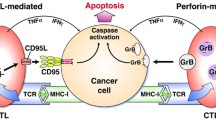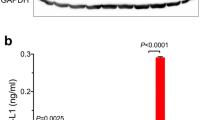Abstract
Caspase-8 (FLICE) can associate with and be activated by CD95 (APO-1/Fas), an apoptosis-inducing member of the Tumour Necrosis Factor receptor family. We find that, in Jurkat T cells, the DNA damaging anti-cancer drug etoposide induces apoptosis and, surprisingly, processing of caspase-8. Therefore, we have investigated whether etoposide involves CD95 receptor activation. We find that etoposide does not induce CD95 ligand expression at the mRNA level. In addition, blocking of CD95 receptor function with a specific antibody does not inhibit etoposide-induced apoptosis. Apparently, in Jurkat cells, etoposide can induce caspase-8 processing and apoptosis in a CD95-independent fashion. Likewise, we find that thymocytes from the CD95-deficient lpr/lpr mouse strain readily undergo apoptosis in response to etoposide. Moreover, since inhibition of the secretory pathway with brefeldin A does not inhibit etoposide-induced apoptosis, we exclude the requirement for a newly synthesizedreceptor ligand to induce the apoptotic pathway. We conclude that, at least in certain cell types, etoposide does not require CD95 receptor function to induce caspase-8 processing and apoptosis.
Similar content being viewed by others
References
Dhein J, Walczak H, Bäumler C, Debatin K-M, Krammer PH. Autocrine T-cell suicide mediated by APO-1/(fas/CD95). Nature 1995; 373: 438-441.
Brunner T, Mogli RJ, LaFace D, et al. Cell-autonomous Fas (CD95)/Fas-ligand interaction mediates activation-induced apoptosis in T cell hybridomas. Nature 1995; vn 373: 441-444.
Ju S-T, Panka DJ, Cul H, et al. Fas (CD95)/FasL interactions required for programmed cell death after T-cell activation. Nature 1995; 373: 444-448.
Russell JH, Rush B, Weaver C, Wang R. Mature T cells of the autoimmune lpr/lpr mice have a defect in antigen-stimulated suicide. Proc Natl Acad Sci USA 1993; 90: 4409-4413.
Singer GC, Abbas A. The Fas antigen is involved in peripheral but not thymic deletion of T lymphocytes in T cell receptor transgenic mice. Immunity 1994; 1: 365-371.
Friesen C, Herr I, Krammer PH, Debatin K-M. Involvement of the CD95 (APO-1/Fas) receptor/ligand system in drug-induced apoptosis in leukemia cells. Nature Med 1996; 2: 574-577.
Müller M, Strand S, Hug H, et al. Drug-induced apoptosis in hepatoma cells is mediated by the CD95 (APO-1/Fas) receptor/ligand system and involves activation of wild type p53. J Clin Invest 1997; 99: 403-413.
Chinnaiyan AM, Dixit VM. The cell-death machine. Curr Biol 1996; 6: 555-562.
Nicholson D, Thornberry NA. Caspases: killer proteases. TIBS 1997; 22: 299-306.
Chinnaiyan AM, O'Rourke K, Tewari M, Dixit VM. FADD, a novel death domain-containing protein, interacts with the death domain of Fas and initiates apoptosis. Cell 1995; 81: 505-512.
Muzio M, Chinnaiyan AM, Kischkel FC, et al. FLICE, a novel FADD-homologous ICE/CED-3-like protease, is recruited to the CD95 (Fas/APO-1) death-inducing signaling complex. Cell 1996; 85: 817-827.
Boldin MP, Goncharov TM, Goltsev YV, Wallach D. Involvement of MACH, a novel MORT1/FADD-interacting protease, in Fas/APO-1-and TNF receptor-induced cell death. Cell 1996; 85: 803-815.
Fernandes-Alnemri T, Armstrong RC, Krebs J, et al. In vitro activation of CPP32 and Mch3 by Mch4, a novel human apoptotic cysteine protease containing two FADD-like domains. Proc Natl Acad Sci USA 1996; 93: 7464-7469.
Chinnaiyan AM, Orth K, O'Rourke K, Duan H, Poirier GG, Dixit VM. Molecular ordering of the cell death pathway. J Biol Chem 1996; 271: 4573-4576.
Schlegel J, Peters I, Orrenius S, et al. CPP-32/Apopain is the key interleukin-1β-converting enzyme-like protease involved in Fas-mediated apoptosis. J Biol Chem 1996; 271: 1841-1844.
Srinivasula SM, Ahmad M, Fernandes-Alnemri T, Litwack G, Alnemri ES. Molecular ordering of the Fas-apoptotic pathway: The Fas/APO-1 protease Mch5 is a CrmA-inhibitable protease that activates multiple Ced-3/ICE-like cysteine proteases. Proc Natl Acad Sci USA 1996; 93: 14486-14491.
Nelson EM, Tewey KM, Liu LF. Mechanism of antitumor drug action: poisoning of mammalian DNA topoisomerase II on DNA by 4'-(9-acridinylamino)-methanesulfon-m-anisidide. Proc Natl Acad Sci USA 1984; 81: 1361-1365.
Chilson OP, Boylston AW, Crumpton MJ. Phaseolus vulgaris phytohaemagglutinin (PHA) binds to the human T lymphocyte antigen receptor. EMBO J 1984; vn 3: 3239-3245.
Ogasawara J, Watenabe-Fukunaga R, Adachi M, et al. Lethal effects of the anti-Fas antibody in mice. Nature 1993; 364: 806-809.
Watanabe-Fukunaga R, Brannan C, Copeland NG, Jenkins NA, Nagata S. Lympho-proliferation disorder in mice explained by defects in Fas antigen that mediates apoptosis. Nature 1992; 356: 314-317.
Yssel H, de Vries JE, Koken M, van Blitterswijk WJ, Spits H. J Immunol Meth 1984; 72: 219-227.
Nicoletti I, Migliorati G, Pagliacci MC, Grignani F, Riccardi C. A rapid and simple method for measuring thymocyte apoptosis by propidium iodide staining and flow cytometry. J Immunol Meth 1991; 139: 271-279.
Vrieling H, Niericker MJ, Simons JWIM, van Zeeland AA. Molecular analysis of mutations induced by N-ethyl-N-nitrosourea at HPRT locus in mouse lymphoma cells. Mut Res 1988; 198: 99-106.
Schuuring E, Verhoeven E, Mooi WJ, Michalides RJAM. Identification and cloning of two overexpressed genes U21B31/PRAD1 and EMS1, within the amplified chromosome 11q13 region in human carcinomas. Oncogene 1992; 7: 355-361.
Medema J-P, Scaffidi C, Kischkel F, et al. FLICE is activated by association with the CD95 death-inducing signaling complex (DISC). EMBO J 1997; 16: 2794-2804.
Dubrez L, Savoy I, Hamman A, Solary E. Pivotal role of a DEVD-sensitive step in etoposide-induced and Fasmediated apoptotic pathways. EMBO J 1996; 15: 5504-5512.
Erhardt P, Cooper G. Activation of the CPP32 apoptotic protease by distinct signaling pathways with differential sensitivity to Bcl-xL. J Biol Chem 1996; 271: 17601-17604.
Martins LM, Kottke T, Mesner PW, et al. Activation of multiple interleukin-1β converting enzyme homologues in cytosol and nuclei of HL-60 cells during etoposide-induced apoptosis. J Biol Chem 1997; 272: 7421-7430.
Pan G, O'Rourke K, Chinnaiyan AM, et al. The receptor for the cytotoxic ligand TRAIL. Science 1997; 276: 111-113.
Chinnayian AM, O'Rourke K, Yu G-L, et al. Signal transduction by DR3, a death domain-containing receptor related to TNFR-1 and CD95. Science 1996; 274: 990-992.
Kitson J, Raven T, Jiang Y-P, et al. A death-domaincontaining receptor that mediates apoptosis. Nature 1996; 384: 372-375.
Marsters SA, Sheridan JP, Donahue CJ, et al. Apo-3, a new member of the tumor necrosis factor receptor family, contains a death domain and activates apoptosis and NF-kB. Curr Biol 1996; 6: 1669-1676.
Bodmer J-L, Burns K, Schneider P, et al. TRAMP, a novel apoptosis-mediating receptor with sequence homology to Tumor Necrosis Factor Receptor 1 and Fas(Apo-1/CD95). Immunity 1997; 6: 79-88.
Fujiwara T, Oda K, Takasuki A, Ikehara Y. Brefeldin A causes disassembly of the Golgi complex and accumulation of secretory proteins in the endoplasmic reticulum. J Biol Chem 1988; 263: 18545-18552.
Tewari M, Quan LT, O'Rourke K, et al. Yama/CPP32b a mammalian homologue of CED-3 is a CrmA-inhibitable protease that cleaves the death substrate poly(ADP-ribose) polymerase. Cell 1995; 81: 801-809.
Clarke AR, Purdie CA, Harrison DJ, Morris RG, Bird CC, Hooper ML, Wyllie AH. Thymocyte apoptosis induced by p53-dependent and independent pathways. Nature 1993; 362: 849-852.
Miyashita T, Reed JC. 1995. Tumor suppressor p53 is a direct transcriptional activator of the human bax gene. Cell 1995; 80: 293-299.
Brady HJM, Salamons GS, Bobeldijk RC, Berns AJM. T cells from baxa transgenic mice show accelerated apoptosis in response to stimuli but do not show restored DNA damage-induced death in the absence of p53. EMBO J 1996; 15: 1221-1230.
Owen-Schaub LB, Zhang W, Cusak JC, et al. Wild-type human p53 and a temperature-sensitive mutant induce Fas/APO-1 expression. Mol Cell Biol 1995; 15: 3032-3040.
Strasser A, Harris AW, Huang DCS, Krammer PH, Cory S. Bcl-2 and Fas/APO-1 regulate distinct pathways to lymphocyte apoptosis. EMBO J 1995; 14: 6136-6147.
Author information
Authors and Affiliations
Rights and permissions
About this article
Cite this article
Boesen-de Cock, J.G.R., de Vries, E., Williams, G.T. et al. The anti-cancer drug etoposide can induce caspase-8 processing and apoptosis in the absence of CD95 receptor-ligand interaction. Apoptosis 3, 17–25 (1998). https://doi.org/10.1023/A:1009603001888
Issue Date:
DOI: https://doi.org/10.1023/A:1009603001888




